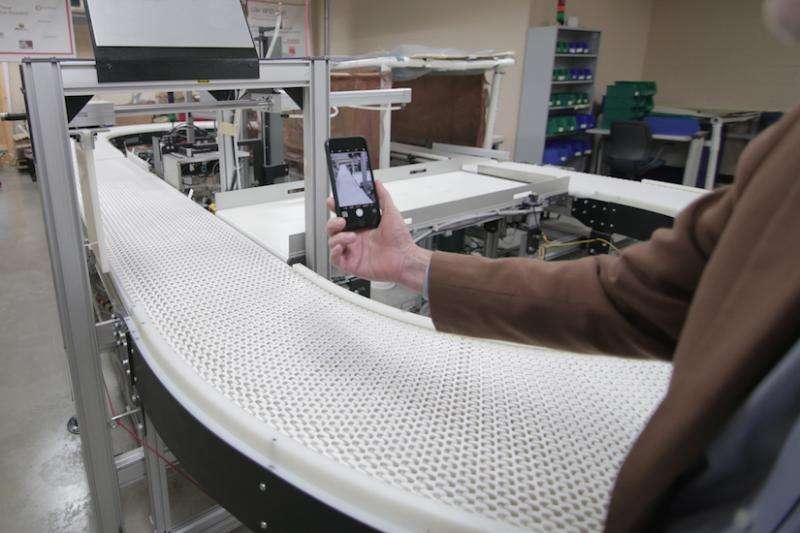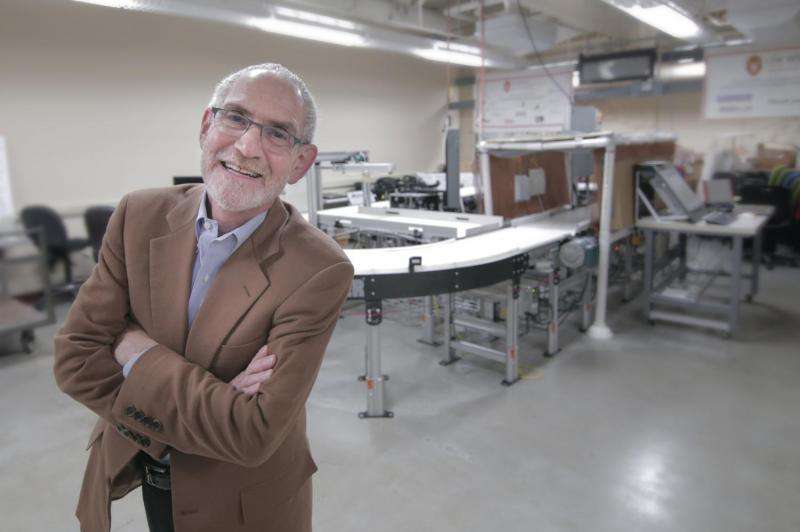Credit: University of Wisconsin-Madison
Manufacturing industries in the United States rely on the tireless efforts of factory employees—who work daily to make, package, prepare and deliver the products we find on our shelves.
And there's a lot of physical effort required of factory workers. The strain of repetitive motion can lead to various musculoskeletal injuries, such as carpal tunnel syndrome or tendonitis in the wrists, arms and shoulders. Risks of injury not only cause workers to suffer, but can create massive inefficiencies for companies themselves, through hidden costs such as workers' compensation, lost time and reduced productivity.
"We want to solve these problems before people get hurt," says Rob Radwin, a professor of industrial systems of engineering at the University of Wisconsin-Madison. Radwin has been studying this problem for more than two decades, and with the advent of technology, he may be able to create a solution that is easy, efficient and economically viable.
Existing methods for measuring risk of injury leave much to be desired: Health and safety professionals often make subjective judgments of risk based on a 0-10 scale of hand activity. Although these measurements provide fairly reasonable predictions, there is immense room for error in human observation, and such conclusions require valuable time, expertise and training in ergonomics and safety. It also requires following the nuanced actions of many individuals over a long period of time. Current technology may be the key to facing, and ultimately fixing, this issue.
Radwin and his students are collaborating with Yu Hen Hu, a professor of electrical and computer engineering at UW-Madison. They already have developed computer vision algorithms to calculate hand activity level, funded through exploratory grants from the National Institute for Occupational Safety and Health (NIOSH) and the National Institutes of Health. In September 2016, Radwin received additional three-year funding of $1.4 million from the NIOSH Centers for Disease Control and Prevention.
This new grant will allow Radwin and his colleagues to use videos collected from a variety of institutions—among them, UC-Berkeley, NIOSH, and the State of Washington Department of Labor and Industries—to develop an entirely new measure for assessing health outcomes. This measure will use their video footage to visualize and track repetitive motions—establishing pattern recognition at which the hand demonstrates repetitive movements, grasps and exertions. By combining their recent epidemiology findings with this new measurement, they can create a basis for engineers to measure risk for injuries and redesign certain jobs in the workplace.
Rob Radwin. Credit: University of Wisconsin-Madison
The ultimate goal is to not only create functioning, accurate measurements, but to make them widely accessible to companies via computer vision. This is where smartphones come in.
"I envision an app, and I think all the technology we need exists on my smartphone today: a high definition camera, a high-speed processor, and the ability to do cloud computing," he says.
If Radwin can apply his measures to a smartphone application, manufacturing employers could assess risk of injury of their employees with relative ease. This would involve simply pointing a handheld video device, which is less intrusive and time-consuming than existing methods, such as attaching an instrument to a worker's arm or hand.
"We can program phones to measure motions and quantify them in a way that is not only more accurate than the current method, but also automatic and more objective and reliable," he says. "It's not just for big corporations using ergonomics to cut costs—it would allow medium-sized and small businesses to access this technology as well."
Combining the assets of multiple disciplines—electrical and computer engineering, industrial and systems engineering, and biomedical engineering—Radwin's research will help companies make often simple, but impactful changes to high risk jobs. The measurements can assess factors such as speed—for example, if a worker is struggling to keep up with a conveyer belt, they may have to move their arms and hands faster to keep up, leading to fatigue and potential injury. New measures would be able to pinpoint such hazards, so employers could figure out how to engineer things like excess speed out of the task. Sometimes problems like these require relatively minor fixes, such as limiting the distances that a worker has to move objects so they won't be forced to move too quickly.
"Sometimes it's not obvious until you try and break down the task into its components," Radwin says.
However, by looking at existing videos of worker motions, Radwin can use the same concept to ensure that these problems don't arise in the first place. "Now we can understand how to look at various factors in a job, and try to engineer out hazards before individuals are even involved. That's our goal, and the goal of companies today, to do it right the first time."
Provided by University of Wisconsin-Madison




















